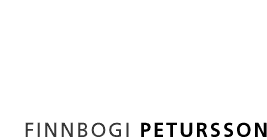
|
Sea state 2014 -2015 The art of Finnbogi Pétursson constitutes a coordinate between engineering and mathematics. A coordinate uniquely determines the the point where three lines meet and coordinates are precisely central to the works Finnbogi puts on display in Dahlshus this summer. These works consist of drawings which he weaves by simulating the conditions in the rich fishing grounds outside the fjords of East Iceland, more precisely off the mouth of Reydarfjordur. There are few better kept secrets in the history of icelandic fishing than the location of resourceful fishing grounds, the more so the richer they were. Before electronic devices became available to determine the location of boats and vessels, and plentiful waters, fishermen needed to be alert and knowledgeable about landmarks in order to be able to position themselves. Various names were applied to the area around Skrúður, Brökur and Vatternestangi, and these codes were passed on in folklore and registered in notebooks and records kept by mariners, who preserved them as if they were equivalent to the Codex Regius itself. Finnbogi employs advanced information technology to refer to those hidden places, adding the potential effects which the forces of nature may have on sea levels, wave height and ondulation. The moon is dominant factor, but one also has to allow for changing weathers, depressions and highs, storms and rains, aspects which render the Icelandic seas notoriously dangerous. Mastering and combining all those variables, aided by the programmes employed, Finnbogi assumes a devine role, steering through his equipment the gravitation of celestial bodies, precipitation, the weather. Association with the devine has always provided artists with a particular impetus and drive, as they happen to share the power of creativity with more heavenly makers. The ink pen of Finnbogi, programmed and inspired, draws up reticulations which resemble the transparent graphs of mountainous subaquatic peninsulas, with peaks and vales, and illustrates them in ondulating three dimensional sections. By blending the ink towards a brown color he succeeds in creating an even stronger sense of depth without compromising the simplicity of the linear interplay. But since drawings on paper may seem far removed from the instant moment, the artist feels an urge to interrupt the standstill with a laser beam, whose movement, constantly seeking an equilibrium, is caused by the rotation of authentic irregularly shaped camshafts. By so emphasizing the presence of the undercurrents, the covert strength of the ocean deep, the beams dance on the wall, the artist brings us the sensation of being in open sea where no lines are entirely still or vertical, but hover relentlessly to and fro. Before we know our bodies unconsciously begin to bend and tilt on dry land. The art of Finnbogi Petursson is never detached from its intimate environment, but it makes us better equipped to encounter the unexpected, the things that are so close and supremely natural that we have forgotten the adventure they represent. Halldór Björn Runólfsson
List Finnboga Péturssonar myndar hnit með verkfræði og stærðfræði. Hnit er það kallað þegar þrjár línur skerast í einum punkti og hnit er einmitt þungamiðjan í þeim verkum sem hann sýnir í Dahlshúsi á Eskifirði í sumar. Það eru teikningar, sem hann prjónar með aðstoð tölvustýrðs rita af miðum úti fyrir Austfjörðum, umhverfis mynni Reyðarfjarðar. Fátt leyndarmál var betur varðveitt í íslenskri atvinnusögu og staðsetning fiskimiða, einkum ef þau voru fengsæl. Áður en rafræn tæki komu til sögunnar til að staðsetja fiskiskip og báta þurftu sjómenn að vera vakandi yfir kennileitum til að staðsetja sig. Ýmis heiti voru notuð á svæðinu milli Skrúðs, Braka og Vattarnestanga, sem geymd eru í munnmælum og miðabókum, ritum úr fórum formanna, sem gættu þeirra eins og væru þær ígildi sjálfrar Konungsbókar. Finnbogi notar háþróaða tölvutækni til að skírskota til þessara leyndu svæða, að viðbættum þeim mögulegu áhrifum, sem kraftar náttúrunnar hafa á sjávarhæð, öldugang og bylgjuhreyfingar. Í því sambandi er máninn öflugastur, en einnig verður að gæta að virkni veðrabrigða, lægða og háþrýtings, roks og rigningar, þátta sem gera Íslandsmið að einhverjum þeim hættulegustu, sem fyrirfinnast. Með alla þessa þætti í höndum sér, gegnum þar til gerð forrit, má líta á stöðu Finnboga sem guðdómlega, þar sem hann stýrir gegnum tæki sín aðdráttarafli himintungla, vatns og veðra. Bein tengsl við almættið hefur alltaf verið ákveðinn drifkraftur listamanna, enda eiga þeir sköpunarmáttinn sammerktan með æðri máttarvöldum. Blekpenni Finnboga, beintengdur ritanum dregur upp möskva, sem minna á gagnsætt graf fjallgarða, með tindum og dölum og birtir þá í bylgjandi fjarvíddarsniði. Með blöndun bleksins út í dökkbrúnan nær hann að laða fram en sterkari dýptartilfinningu í teikningum sínum án þess að missa sjónar af einfaldleika línuspilsins. En sökum þess hve teikningar á blaði eru fjarri augnablikinu fannst listamanninum hann þurfa að brjóta upp kyrrstöðuna með leisigeisla, sem vegur salt á einföldum, heimasmíðuðum knastási. Við það laðar hann fram undirölduna, dulda krafta sædjúpana, sem dansa á veggjunum og færa okkur heim tilfinninguna fyrir rúmsjónum þar sem línan er aldrei fullkomlega ládauð heldur bifast upp og niður, út á hlið, og verður til þess að við förum ósjálfrátt að stíga ölduna á þurru landi. List Finnboga Péturssonar er aldrei laus við tengsl sín við nærumhverfið, en hún veldur því að við áttum okkur ætíð á hinu óvænta, því sem er svo nærtækt og ofurmáta eðlilegt að við höfum gleymt ævintýrinu, sem í því felst.
- Halldór Björn Runólfsson, 2014 |